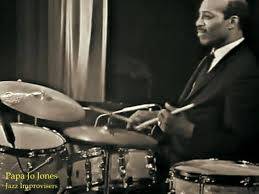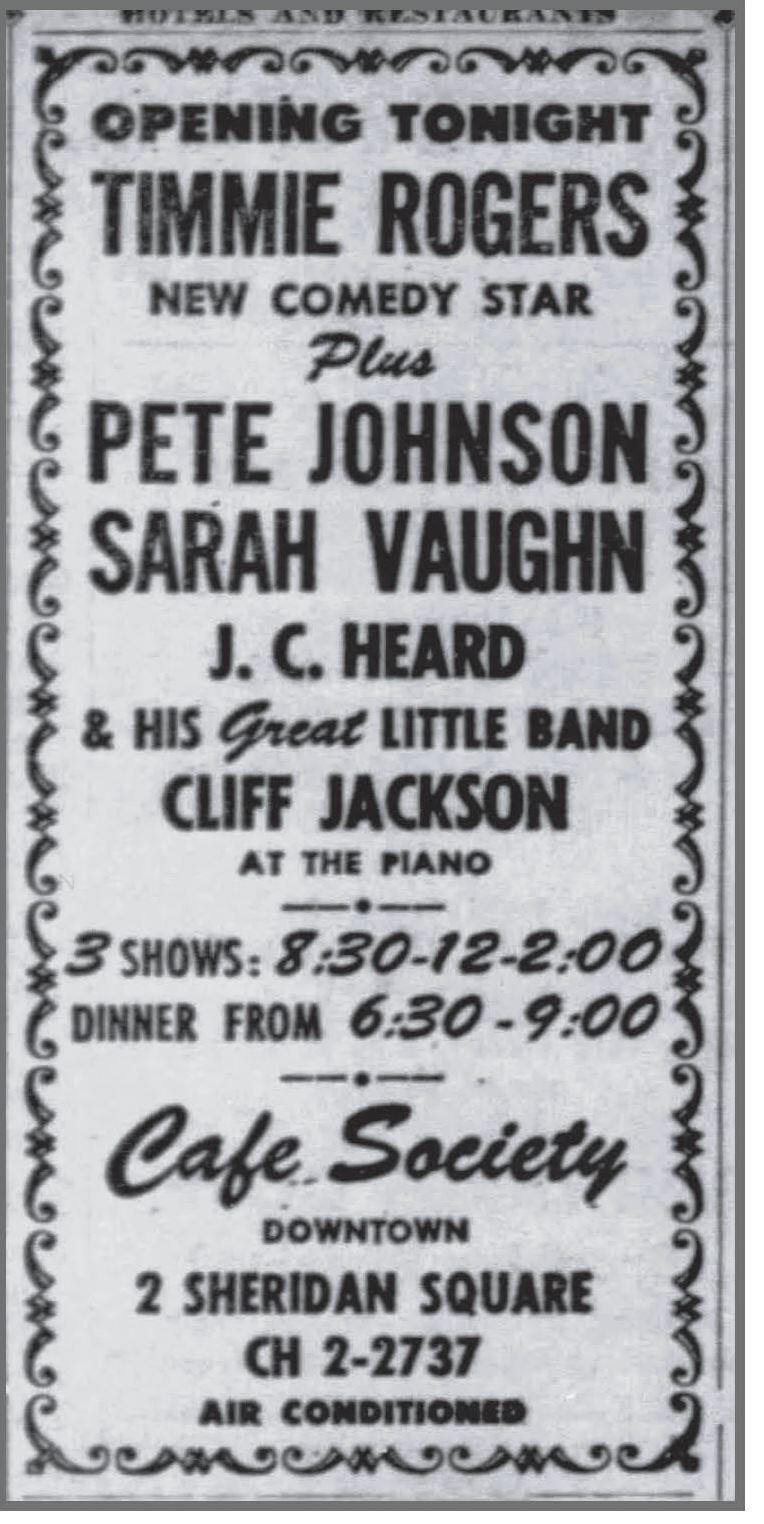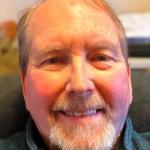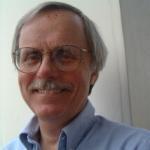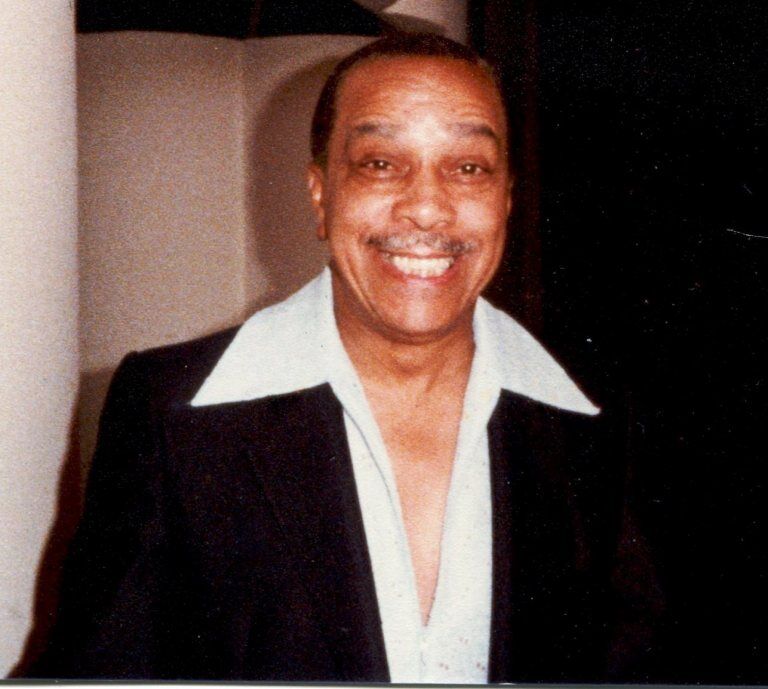
J.C. Heard (1918 – 1988) left a large legacy to the jazz world. He’s on many important records, he played in amazing bands, he spread the jazz doctrine to Japan, and he was a vital force on Detroit’s jazz scene. Every year the Detroit Jazz Festival honors his legacy. Lars Bjorn and I honor his memory with this biography.
J.C. Heard was a drummer/percussionist, vocalist, bandleader, soloist, Japanese film star and talk show host. He could communicate with people in all walks of life. His anecdotes (and he had many) were hugely entertaining. He exemplified the best qualities of a jazz musician – a strong sense of style, confidence, personal warmth, passion, and immense talent. He didn’t play his drums so much as command them.
Heard was known as a “utility drummer” to record producers in 1940s Manhattan – able to fit into any situation and excel; he seemingly never had a bad drum day, at least on recordings. From Sidney Bechet to Charlie Parker, Heard always established a groove and kept the rhythm going. An accomplished tap dancer, he had a strong feel for rhythm and could establish a good tempo for dancers. Heard fit in with bands of any size or style, and instrumentalists or singers of any persuasion. He never lacked for work and made good money as a free lance.
Heard drummed on dozens of sessions in the mid-forties, including two dates with Charlie Parker, sessions with tenorists Don Byas, Ike Quebec, Illinois Jacquet, and Lester Young, trumpeter Dizzy Gillespie, folk singer Josh White, and jazz icon, Billie Holiday. He got up close and personal with pianists Earl Hines, Joe Turner, Toshiko Akiyoshi, Pete Johnson, Mary Lou Williams and Oscar Peterson. He recorded with some of those musicians multiple times over many years.
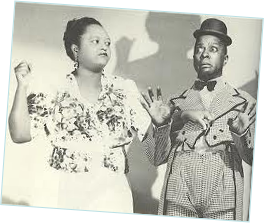
Born in Roanoke, Alabama, on August 10, 1918, J.C. (he became “James Charles” when he applied for a passport – initials are not accepted) was the eldest of four children: Classie Lee (1920), David (1922), and Shirley (1933) rounded out Louis and Ina (Ford) Heard’s family. They relocated to Dayton, Ohio, when J.C. was in diapers. The next move was to Detroit, around 1925, to Redford Township. David remembers J.C. “banging on my mother’s pots and pans. I knew early on he was going to be a hell of a drummer someday.”[1] Ina saved soap coupons and bought J.C. a single snare with a stand, which he used to play along with records. Both brothers and their sister Classie loved to tap dance, and they worked out routines to their favorite swing recordings. Heard started his professional career as a tap dancer, and got his first break at Detroit’s Koppin Theater[2] when the drummer for popular vaudeville act Butterbeans & Susie became ill, and Heard, already on the bill as “The Child Wonder,” filled in.[3] “I was so small they had to pad the seat with cushions so I could reach the traps,” he said of these early appearances.[4]
Heard’s mother also took J.C. to the Graystone Ballroom, where he got to hear premier hide beaters like Jimmy Crawford (with Jimmie Lunceford), but it was the great Chick Webb who made the deepest impression. “I had never heard anybody play drums like that in my life,” he stated. “In comparison, it seemed as though a lot of fellows had just been keeping time.”[5]
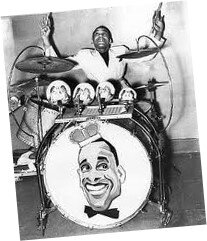
Heard recalled how Ina “used to ‘carry me around’ when I played in bands and was too young to be let in alone.” Saxophonist Joe Norris recalled hiring a too-young J.C. Heard, which confirms Heard was a prodigy (and a competent drummer) rather than a novelty act.[6]Norris was picky about musicians he hired.
J.C. later went to Cass Technical High School. Cass Tech offered advanced curricula in several disciplines and Heard was able to devote himself to music the better part of each school day, playing in marching and dance bands as well as practicing with like-minded students such as bassist Al McKibbon, who later became his brother-in-law. “J.C. used to tap his ass off,” McKibbon recalled. “When we were both going to Cass we’d dance around school there.”[7] Within a year of finishing High School, Heard was in Manhattan, drumming in pianist Teddy Wilson’s short-lived big band.
Heard’s first steady job after Cass was with trumpeter Bill Johnson in 1938 at the Cozy Corner Café, located on Hastings Street in Paradise Valley. The Cozy was a popular Black and Tan with a floor show. Johnson had a tight six piece combo and was open to jamming. “Everybody used to come by,” Heard recalled, including well-known jazzers like trumpeter Roy Eldridge and clarinetist Benny Goodman.[8]
During a job at the Graystone Ballroom with Count Basie’s orchestra on July 3, 1938, Basie’s ace drummer Jo Jones dropped by. “Jo came over to where I was playing,” Heard recalled. “and said, ‘you’re going over and play with Basie tonight!’ He could be very insistent, so I went, and Basie and all the boys liked me.” Basie’s trumpeter Buck Clayton recalled that “J.C. Heard was the only one who truly played like Jo.”[9]
Jones’ style and drive helped create Basie’s unique sound and rhythmic identity. “Jo was a master with the sock cymbal,” said Heard. Like his mentor, J.C. developed cymbal playing to a fine art. He also thrived on assorted drum rhythms: Latin, African, Cuban, Calypso, and of course four-four. Heard “thinks the drums should be played like an instrument, but like an instrument without melody. They should be phrased same as the horns, but they can have no melody to work with,” according to Margie Keane.[10]
Jones recommended Heard to pianist Teddy Wilson, who was preparing to leave Benny Goodman.[11] Wilson likely heard J.C. in August, 1938, during Goodman’s Detroit visit, and he dropped by the Cozy during the Goodman orchestra’s engagement at the Fox Theater in March, 1939, to seal the deal.[12] [13] Wilson quit the Goodman Ork at the end of the Fox gig. When a telegram confirming J.C.’s employment with Wilson arrived at the Heard household, J.C. “ran around the house yelling ‘Mama, Mama, I’m going to New York City,’” Dave recalled with a chuckle. Wilson’s orchestra played its first job in April.[14]
Heard dug Wilson’s piano groove, and Teddy brought the same elegance and swing to his big band. “I loved that band, man,” said J.C. “They played so clean and beautiful.” But, there was a problem. “We had a beautiful library and Ben Webster too, but that wasn’t enough. Teddy was a piano player, not an entertainer.” Heard sang on Wham, a novelty number of the time. Wilson had a Brunswick recording contract, and he also backed up countrified vocalist Redd Evans (those were Heard’s first records). Wilson had good jobs lined up, but he didn’t click with the public. By spring, 1940, his orchestra was history.





Wilson scaled back to a sextet, and J.C. remained, off and on, for another year. They played at Café Society Downtown, a stylish Manhattan nitery billed as “the wrong place for the right people”. Segregation was forbidden in the venue. There were stellar intermission pianists the caliber of Meade Lux Lewis, Albert Ammons, and Pete Johnson. Wilson’s band, including the ever-smiling drummer, made a soundie (the equivalent of today’s music video). J.C. liked the venue, and struck up a friendship with owner Barney Josephson. His concept of a Jazz band -Jazz presented in an entertaining setting – fit perfectly within the club’s boundaries..
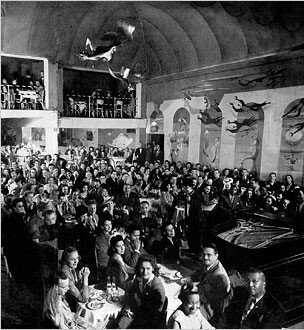
Heard was a first-call sub and worked with the best bands around town, including saxophonists Louis Jordan, Coleman Hawkins, and Benny Carter (he recorded with Hawk and Carter). J.C. told Jim that Hawkins was similar to Wilson and Carter, they were not entertainers. Hawk’s passion was Music, not leading a band. Heard learned quickly that audience interaction was an important component of success. Carter’s music was difficult and required a high level of musicianship. “J.C. was one of the best drummers around,” Carter told Gallert.[15]
After free-lancing around Manhattan for most of 1942, Heard was hired in the fall to replace Cozy Cole with Cab Calloway’s orchestra. That was a swell job, offering good money and quality working conditions. When Heard was with Calloway, he told the musicians to “watch me, baby – I’ll set the tempo. Don’t pay any attention to Cab.” Heard made a positive impression on the musicians, especially his rhythm section partners.[16] Guitarist Danny Barker told Jim that “the rhythm in Cab’s band didn’t get right until J.C. joined.”[17] J.C. wrote Coastin’ With J.C., which the band sometimes used as their closing theme.

Working with the Cab Calloway Orchestra was the first time J.C. Heard toured. He always praised their always first-class accommodations and Cab’s professionalism. The band appeared in two feature films, “Stormy Weather,” (which has a slam-bang dance sequence by the Nicholas Brothers), and “Sensations of 1945.” The Calloway orchestra played Detroit frequently during Heard’s nearly three-year tenure with the band – five times at the Paradise Theater and a single date at the Broadway Capitol downtown. Detroiters always support a “hometown boy” and J.C. was a popular guy.
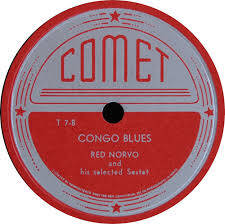
Heard left the Calloway band late in 1945 and looked for work in Manhattan, this time as a leader. Calloway’s band was a “finishing school” for entertainers, and J.C. studied Cab’s deportment and no-nonsense leadership style. “That’s where I learned a lot about the show business side, since I had a chance to play with all the top dance teams and singers.”[18]
J.C. also met Mary Lou Williams. He was in Williams’ December 1945 group which presented her “Zodiac Suite” at Manhattan’s Town Hall. Heard drummed on several sessions for his friend Harry Lim’s Keynote Records, including his first as a leader (August 17, 1945).



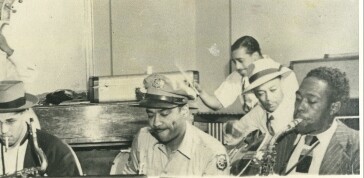
1946 was a banner year for J.C. Heard. He and Charlie Parker were among the Esquire “New Star” award winners.[19] The award was given by Esquire Magazine, which was then focused on jazz. The New Star awardees were selected by musicians rather than critics or fans, which lent credence to the process. The winners waxed four landmark titles for RCA-Victor in February 1946 for their New 52nd Street Jazz album. J.C. keeps it all moving, adding spicy accents completely in keeping with “the new Jazz” then flowering in Manhattan and spreading to other localities. Just a few weeks later, Heard inked a deal with Barney Josephson to be the house band at Café Society Downtown, a contract that began in March, 1946 and lasted a year.[20]
Heard turned twenty-eight in 1946. He was fully embedded in New York City. He had a solid reputation and tremendous energy. He landed a record deal with Continental Records and waxed four titles later that month. The two recording sessions display current and future Jazz directions, and show how “at home” Heard was in both settings. He’d recorded with Sidney Bechet in 1941, and he fitted with Bechet, too. Heard was among those select few drummers (like Kenny Clarke, Sid Catlett, and Dave Tough) who could easily slide through eras from Bechet to Bird, and beyond.
J.C. assembled a combo based around his bassist and brother-in-law, Al McKibbon. Heard’s combo first included trumpeter George Treadwell, (later replaced by Joe Newman), tenorist Budd Johnson (replaced by George “Big Nick” Nicholas), trombonist Dicky Wells (Dickie Harris came later), pianist Jimmy Jones and bassist Al McKibbon. Jones and Jimmy Mundy contributed charts. Etta Jones, a minor at the time, was Heard’s first vocalist. A young Sarah Vaughan made some early appearances with Heard’s combo. The band has a brief spot in the 1946 Noir thriller, “Kiss Of Death.”

J.C.’s well-groomed little band reflected the leader’s penchant for presentation: tasty arrangements (including vocals by Heard), solo features for the leader, and a nice mix of material. Bouncin’ For Barney, a re-titled Coastin’ With J.C., served as Heard’s theme.
J.C.’s band garnered good press from Billboard, which reviewed the bill at Loew’s State Theater in New York on March 13, 1947. Several bands appeared, but the…
“…standout is J.C. Heard’s Ork, making it’s Vaude (sic) bow after a year of nitery work at Cafe Society Downtown. Live little combo should move fast on the Vaude circuit after more footlight experience. Best jobs were on, Bottom’s Up and Wild Man’s Dream. Latter number, as the closer, was made effective by the rest of the band quietly withdrawing from the stage to leave the leader in the spotlight beating out snappy drum syncopation.”
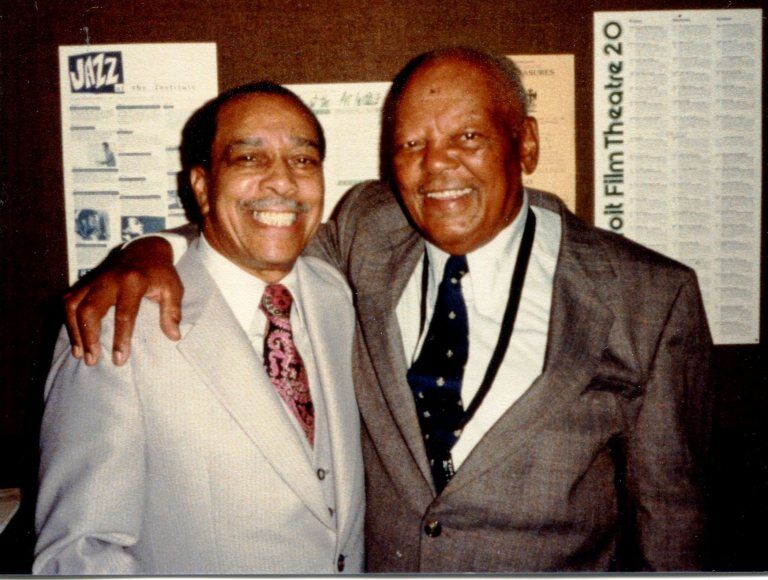
Heard’s records got a fair review from Down Beat magazine.[21] J.C.’s group recorded with Etta, Sarah, comic Timme Rogers, Ethel Waters, and Dusty Fletcher (of Open The Door, Richard fame.) Those recording dates were interspersed among recording sessions with Josh White, J.A.T.P., Teddy Wilson, Cab Calloway, and Ike Quebec. J. was “driving a Cadillac and living on Sugar Hill,” Dave recalled. “He was living the good life.”
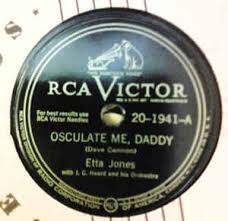
Heard brought his group, including vocalist Etta Jones, to Detroit’s Club El Sino for a two week stand in August, 1947 as part of a Midwest tour. Back in N.Y., J.C. kept busy playing benefits, a gig for the “New Jazz Federation” (which included Buck Clayton and Erroll Garner), and other gigs.
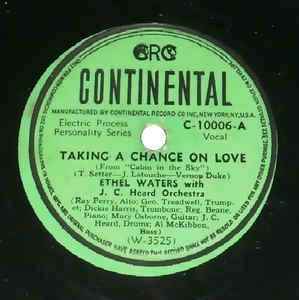
Heard’s appearance at the tenth annual Amsterdam Star-News Benefit for the Harlem Needy, got him canned. His band’s time slot was close to his Café Society start time, so close that Josephson arranged for a police escort to and fro, to ensure patrons would miss not a single drum roll! Regrettably, there was a departure delay, and not even the cops could get them to the club in time. They arrived twenty minutes late, and Josephson was seething. He fired Heard on the spot – perhaps forgetting he’d given them permission to play the benefit in the first place!
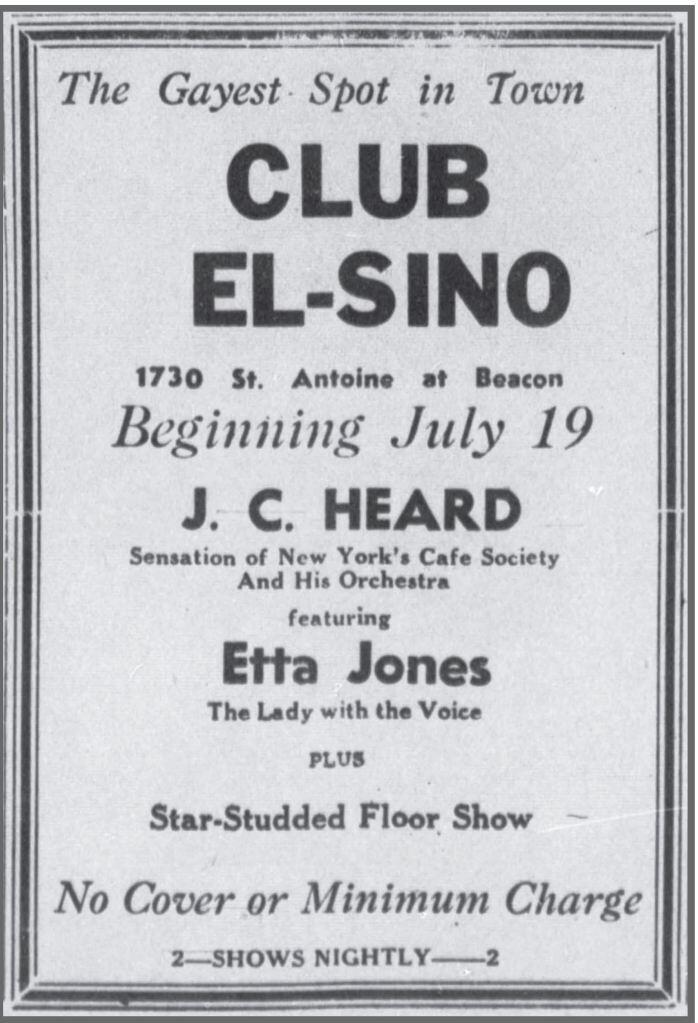
J.C. was stunned, and he took the matter before the Board of A.F.M. Local 802. To paraphrase the New York Age, “After a Union hearing lasting almost one hour, it became clear the Union Board would sustain Heard’s position. The Café management thereupon withdrew it’s dismissal notice, Heard withdrew his complaint, and the two men are arm-in-arming it once again.” Heard had high standards of conduct and punctuality is near the top of his list. J.C.’s contract was nearly up, but he would again appear at the Café.
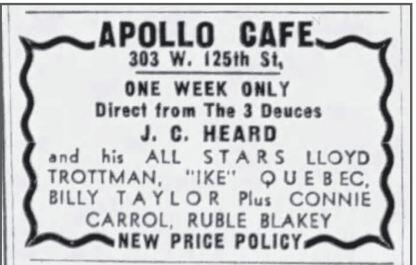
Another significant event in Heard’s life was his association with Norman Granz’s “Jazz At The Philharmonic” extravaganza. Heard and Granz first met when Cab Calloway’s band was in Los Angeles. Granz was one of the few promoters Heard truly admired. “Norman had complete class, man,” he said. “First class all the way – best of everything, and he stuck up for us too.” Granz essentially put together a traveling jam session comprising jazz stars, many of whom recorded for his record label, and took his show on the road, first around America, then around the world.
The title of Tad Hershorn’s excellent Granz biography, Using Jazz For Justice, tells us a lot about Mr. Granz. Granz refused to accept bookings for venues that enforced segregated seating. He would not accept racism in any form, which earned him respect from musicians and sometimes influenced their tour routes. Heard was the perfect choice for J.A.T.P. He’d played with, or knew most Manhattan musicians, and his flexibility was a great advantage. Every soloist wanted some J.C. sugar – slick licks and accents to propel them along. There were all-out “drum battles” on certain tours, featuring Heard, Buddy Rich, or Gene Krupa. Granz’s concerts were always well attended in Detroit.
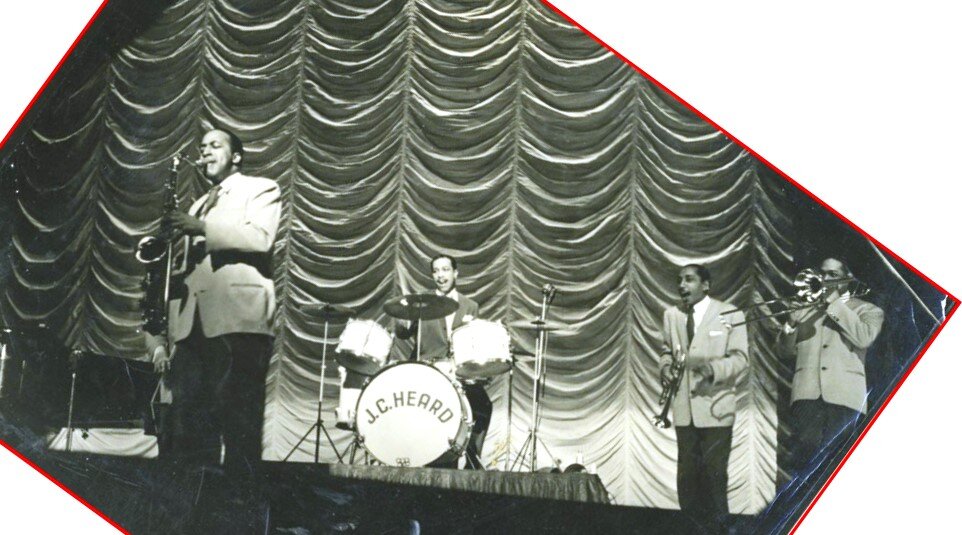
From 1950 – 1953, J.C. drummed on sessions for Johnny Hodges, Lester Young, Billie Holiday, and Illinois Jacquet, among others. He’d first recorded for Norman Granz in 1946, on a Carnegie Hall Jazz At The Philharmonic (J.A.T.P.) date.
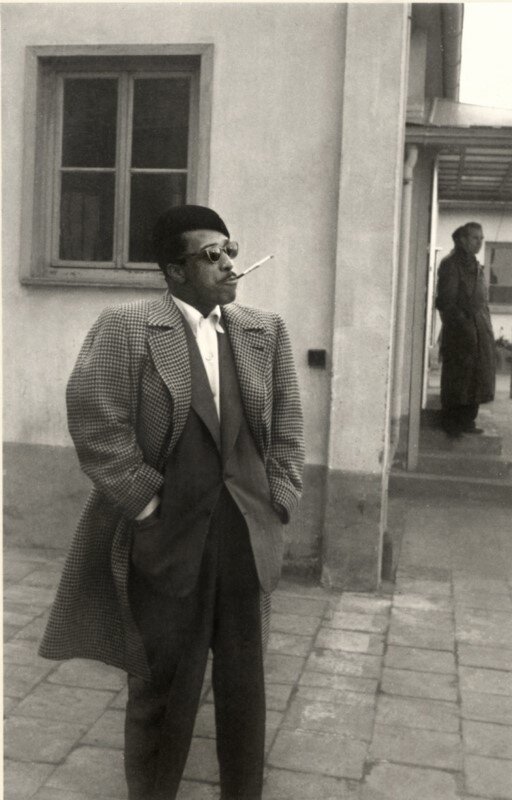
J.A.T.P.’s 13th National Tour kicked off in the fall of 1953. Heard was out of town – Honolulu, Hawaii – so he met the group there. The troupe continued to Australia, finally arriving in Japan in late November 1953.[22] At the end of the two-week tour, their Japanese promoter asked if any of the musicians wished to stay in Japan? There was plenty of work, and he would pay double what Granz paid. Heard said, “yes!” Some of his colleagues tried to dissuade him from staying, but Heard, always up for an adventure, sensed this was an opportunity. He could sing, dance, play various percussion instruments, and was comfortable in any social setting. He connected “Jazz” and “Show Business” and believed the music should entertain as well as enlighten.
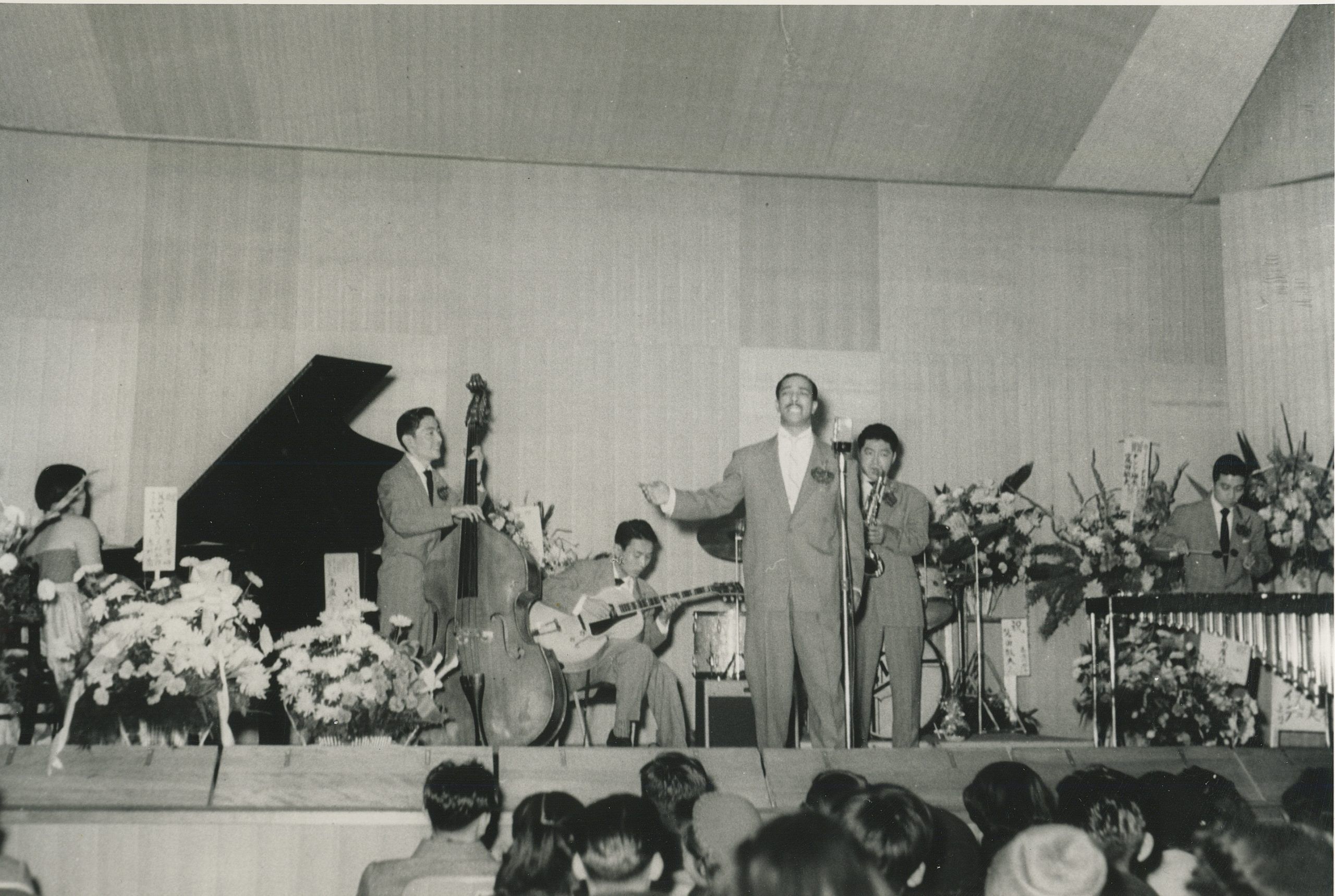
Heard fell in love with Japan. “They gave us a wonderful reception,” he told Jazz writer Don Demichael. “They paraded us through Tokyo for three hours – a real ticker-tape parade.” The Japanese loved jazz, and musicians were eager to learn from J.C.. He led his own group, gave lectures and lessons, and encouraged nascent modern players like pianist Toshiko Akiyoshi, with whom he recorded. She remembers meeting J.C. after a J.A.T.P. concert. “He was a very nice man,” she told me. “When we made the record I was very nervous. J.C. tried to make me relaxed.” Toshiko recalled that Heard “played clubs in Tokyo. He was a ‘one-man band.’[23] Heard acted in four films. “In the first one, I was a G.I. who tried to get the hero’s girl, but the good guy got her back,” J.C. remembered. In another film, Heard, dressed in traditional Japanese robes, was supposed to behead a girl with his Samurai sword.[24] He also hosted a talk show (using a translator), and met his future wife, a lovely and gracious model named Hiroko Nagata. They fell in love and became a couple. Hiroko worked behind the scenes, arranging appearances, deals, and publicity. J.C. even popped out to Manilla, Philippines, for a six-week gig in the summer of 1954.
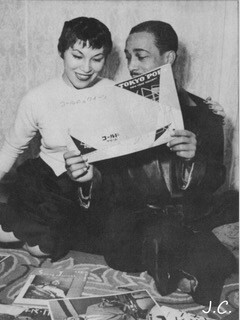
Heard’s life was moving at a brisk tempo, a tempo that accelerated when Hiroko became pregnant with their son. J.C. welcomed the news and began planning a tour, where the money was better. He left Japan at the end of May 1955 and drummed his way around Southeast Asia. Unfortunately, he overstayed his Visa time limit and was not allowed to return. This didn’t faze Heard, he simply stayed on the road. He returned to the U.S. in November 1957 and resumed working part-time for Norman Granz, touring and making records. J.C. recorded an LP in 1958, in Chicago, for the Argo label that was produced by his longtime friend Dave Usher. Like his 1946 Continental recordings, it’s a good overview of his talents.
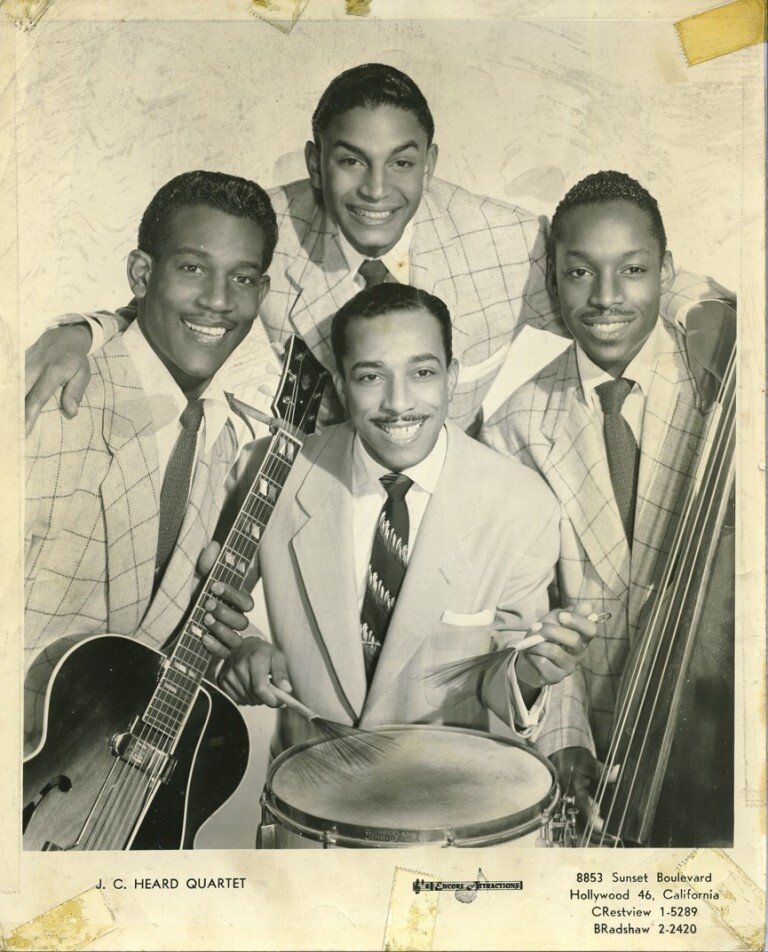
Al McKibbon had been pressing J.C. to move to Los Angeles (Al had been on the left coast since 1958), and Heard made his move in the early 1960s. J. worked in many different settings, including a drum duo with veteran percussionist, Jack Sperling, and a wonderful quintet at the Lighthouse with ace saxman Bill Perkins in 1964.
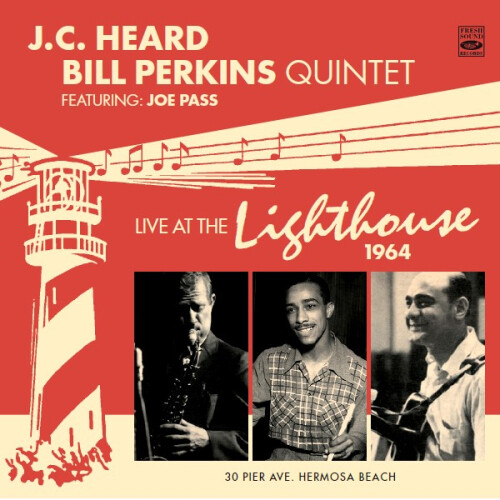
The latter group was taped in action, and the results (issued on Fresh Sounds records) are great!
He ended up in Miami, Florida, in April 1963. He was a member of pianist Dorothy Donegan’s trio for several months. The montage of newspaper adverts below shows what J.C. was up to.





Heard moved back to Detroit in 1965, twenty-five years after leaving to join Teddy Wilson’s orchestra. He managed to get his son, Eric, to the States in 1967, followed shortly after by Hiroko. Eric was in awe of his famous father. That quickly changed, and the two became inseparable. Eric went “everywhere” with J.C., including to Europe in 1978. Eric was on his High School wrestling team, and he took piano lessons after school. J. was “hoping I’d be a Jazz pianist, but one day I came home after wrestling and said, ‘I don’t feel like playing piano.’ That was the end of that!”
Folks who heard J.C. back in the day were now comfortably middle-aged. Detroit teenagers were into Motown, Soul, and/or Rock ‘n Roll, with chunks of Jazz, Blues, Country, and Folk music added. Heard had to re-establish himself. He loved drumming for a big band, and Detroit had several fine aggregations, but the percussion chairs were taken. J.C. had a fallback position. He organized a trio featuring organ and guitar and scoured the area for employment. His gift for gab and stellar rhythmic skills ensured he had steady work. There were regular calls for “All-Star” bands with visiting musicians such as Budd Johnson, Zoot Sims, Johnny Guarnieri, and Doc Cheatham.


Heard got a slot on Teen Time with this release. J. loved all rhythm

This venue was located on Livernois immediately South of Baker’s. Keyboard Lounge

J.C. worked in a trio setting for years.
Heard kept tinkering with bands, putting his varied talents on display. He recorded a funky number called J.C.’s Grit Getter that garnered some airplay and got him a slot on Robin Seymour’s “Swingin’ Time”, a popular TV show for teens. Eric went on the gig with his dad, who mimed the words to his song.

J.C. was liable to turn up anywhere, with any size band. He led an organ trio at the Playboy Club, a straight-ahead quartet that included pianist Earl Van Riper, bassist Don Mayberry, and tenor ace Charlie Gabriel, at several venues. That was Heard’s working band until his orchestra took off. They’re documented on a long out of print CD. Heard and Ann Arbor pianist Mr. B waxed an album of blues and Boogie-Woogie duets, and J.C. was on several LPs with other Detroit-area musicians, including one for veteran producer Hugh Leal on his Parkwood label with saxophonist George Benson, pianist Claude Black, and Toronto bassist Dave Young. He played at most Detroit Jazz Festivals. In 1984 a swing sextet including Teddy Wilson and Benny Carter performed. At an afternoon rehearsal, the musicians were sitting around a table organizing solo routines and recalling old times. At one point Wilson, recovering from an illness and looking tired, said to Heard, “now, take it easy, J.C. Don’t push too hard! “I’m gonna put my foot right in your ass, baby,” Heard replied, and everybody fell out laughing.

Heard loved to talk about his early days and the wonderful musicians he’d played with, but he wasn’t nostalgic. J. was a regular guest on WDET-FM’s Jazz Yesterday during the 1980s. It was Jim’s show, and he was always finding obscure records on which J.C. played. Heard dug listening to his colleagues from the old days, and would always exclaim, “Ha! Another great one!” when familiar sounds filled the studio. Jim once played Big Chief Pawnee, from a Rex Stewart record date on July 30, 1945, which had a vocal trio making “Indian” type whoops. J. hadn’t heard the record before, and he cracked up at the vocal effects – he’d been in the trio! Heard was a great advocate for jazz, and would sometimes shake his head and say, “they’ll never kill jazz – I don’t care what they do!” when informed of a Jazz venue closing its doors, or opting for rock instead of jazz.

At heart, J.C. Heard was a modernist. “He was always listening to the younger guys,” said his bassist, Jeff Halsey. “That’s what kept him young. I remember his zest for life, and I remember J.C. I think about him every day.”[25] Halsey, a ripe twenty-five years old when he started playing with Heard in the early 80’s, marveled at Heard’s sound and rhythmic conception.
“J. had a beat as wide as Jimmy Rushing,” Halsey said. “I loved to go to work because I knew we would lock in and swing like crazy.” J.C. brought an Afro-Cuban sensibility to his playing, Halsey remembered, and this influenced his sound; he would sometimes ‘pitch’ his snare with his elbow during a solo. Walt Szymanski, his Music Director, arranged Juan Tizol’s Conga Brava as a feature for Heard, and J.C. would incorporate Afro-Cuban feeling (and licks) during his workout.
One of Heard’s strategies for success was to keep his musicians happy. “I’ll keep the boys happy,” he said during his 1947 Café Society Downtown gig, ”and we’ll go on from there. Musicians can’t do their best work when they’re miserable.”[26]
Forty years later, he expressed the same thought to Szymanski. “J.C. was really savvy,” Szymanski recalled. “He wanted to see smiles on our faces, so he paid everybody at intermission!” Heard was color-blind, and had no time for promoters who asked about the racial composition of his band. “He’d say, ‘I got a rainbow – which color you want?”
It was important to keep his guys happy because he demanded so much from them. “He was all about the music,” said Szymanski. “If he thought you didn’t give 150%, he’d be all over you. He fired a lot of guys because of that. He was a hard taskmaster, but he was so much fun to be around, and he made you want to play.”[27]
Szymanski and Heard first met on Mackinac Island in 1979. They became friends, and J.C. shared his plan to organize a Big Band, offering Walt the job of music director. “We started out with nine pieces playing Duke Ellington material, and expanded to fourteen after we got going,” Szymanski recalled. In this case, size didn’t matter. “J.C. knew how to swing any size group, that’s why his big band sounded so good – it felt like a small group.” [28]
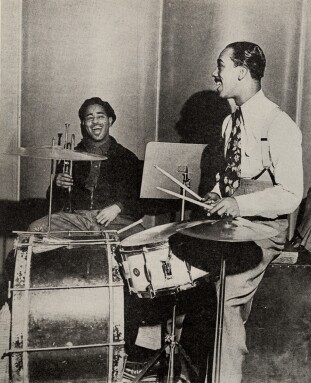
Following their initial appearance at the Detroit Institute of Arts in 1983, the J.C. Heard Orchestra began to attract attention, and was soon booked worldwide. They connected with Dizzy Gillespie, who guested with Heard’s band at the 1984 Montreux-Detroit Kool Jazz Festival. It was a success, and their collaboration picked up steam. There was a tour in the works. Always a rhythm man, Diz had been digging J.C. since the Cozy Corner days. He told the New York Times “three men wrote the rules for modern jazz drumming: Kenny Clarke, Max Roach and J. C. Heard.” Heard’s drumming on the September, 1945 Apollo recording session with Charlie Parker impressed many younger New York musicians.
Heard died on September 27, 1988, two days before a performance with Gillespie at the Detroit Institute of Arts; that concert morphed into a memorial led by Diz, instead of celebrating their forthcoming tour. J.C.’s death effectively ended his band, too. Szymanski led the group for a few jobs, and put together pick-up bands for a sprinkling of gigs. The 2011 Detroit Jazz Festival marked the first bona fide reunion of the J.C. Heard Orchestra.
Heard touched many lives, none more than his son, Eric, now a successful businessman. Eric excelled at sports, not music, and his father always supported and encouraged his interests. “He instilled a strong work ethic in me, told me to always excel.” Eric recalled. “And he taught me to respect my elders.” Heard sometimes took his son to business meetings, including one at the Playboy Club when Eric was twelve, a memory that still brings a smile to Eric’s face.
Regardless of the band, the music, or the gig, Heard “always followed his philosophy,” said Halsey: “Keep it simple, and swing the band.” ‘Keep it simple’ applied to the drum kit as well as the rhythm. Heard had a flashy set-up while with Calloway, but preferred a basic kit. Walking into a club one night, J.C. stared at the drum kit, sitting vacant on stage. It had two bass drums, a hi-hat, multiple snares and tom-toms, and an arc of cymbals which completely hid the drummer. J. chuckled and said “if you can’t swing with a five-piece kit, having all that shit won’t help you.”

Special thanks to Frank Buchman-Moller, Mark Miller, Jean Labaye, Ken Steiner, Mike Montgomery, W. Kim Heron, Toshiko Akiyoshi, Samantha Heard, Mrs. Hiroko Heard, and Eric Heard. All unattributed quotes from J.C. Heard are taken from conversations with Jim Gallert. Photographs courtesy of the Heard family, unless otherwise attributed. N.B.-Detroit’s Jazz Festival underwent several name changes before settling down as The Detroit Jazz Festival.
J.C. Heard on Record
Wilson’s studio recordings with J.C. Heard are available on a Mosaic box set! The Mosaic set also has a previously unissued Wilson Ork broadcast in good sound. http://www.mosaicrecords.com {Classic Brunswick & Columbia Teddy Wilson Sessions 1934-42} This is Me, J.C. – a good showcase for the Maestro. Recorded 1958 J.C. Heard with the Calypso Seven J with an Aussie band A Little Of This, A Little Of That – J.C., big band. Hiroko Records 187 J.C. Heard – Bill Perkins Quintet, Live At The Lighthouse Fresh Sounds
- David Heard, interview by Gallert, April 15, 2011. David had a successful music career in Detroit; he led bands for years, and made some early recordings with Sonny Stitt.
- Local T.O.B.A. theater located at 531 Gratiot in Paradise Valley; the Koppin was the primary venue for African American musical and variety (Vaudeville) acts during the 1920s.
- Heard repeated this story many times over the years and it was pretty consistent. Butterbeans & Susie played Detroit at the Koppin in 1928 and 1929, each time bringing a sizeable troupe, but none of the musicians or other performers are mentioned in the Detroit Owl performance reviews. They also played other Detroit venues in 1926 & 27.
- Margie Keane, “Heard JC,” Unattributed, 1947.
- Phillip Hanson, “Catching up with J.C. Heard,” Jazz Monthly, March 1968.
- Joe Norris, interview by Gallert, June 12, 1989.
- McKibbon, interview by Gallert, Hollywood, California, September 29, 1997. McKibbon and Classie married on June 6, 1940. Other students included saxophonist Ted Buckner and trumpeter Gerald Wilson.
- Wade Boykin, interview by Bjorn, August 1, 1979. Boykin was the pianist in Johnson’s band.
- Burt Korall, Drummin’ Men (New York, N.Y.: Schirmer Books, 1990), 153-4
- Margie Keane, Ibid.
- Wilson and Jones recorded together on October 31 & November 9, 1938.
- “Teddy Wilson Quits Goodman,” Pittsburgh Courier, March 11, 1939.
- “Teddy Wilson Picks Three Detroiters For Band,” Detroit Tribune, February 11, 1939. Wilson also tapped trombonist Jake Wiley and trumpeter Karl George, both from saxophonist Cecil Lee’s band.
- Frank Buchman-Moller, Someone To Watch Over Me: The Life and Music of Ben Webster (Ann Arbor: University of Michigan, 2006), 51
- Gallert conversation with Benny Carter, Detroit, September 1, 1984.
- Heard was indirectly involved in the infamous “spitball incident” that cost Gillespie his job.
- Gallert conversation with Danny Barker, New Orleans, May, 1983.
- Peter Vacher, “Heard about J.C.?,” Melody Maker, November 4, 1978.
- “New Stars” were selected by Esquire’s Board of Musicians. One winner was selected on each instrument. Heard got votes from drummer Sid Catlett, pianist Billy Strayhorn, and saxophonist Johnny Hodges, among others. A total of 41 musicians voted.
- Heard was at the club for 12 months. J.C.’s combo may be briefly heard, and the rhythm section seen, in “Kiss Of Death.”
- Different from the other songs with this title recorded or broadcast by Wardell Gray, and Cab Calloway.
- Heard stayed in Hawaii from August, 1952-November, 1953. He left Japan in May, 1955, and was in Australia in 1956. He may have visited other countries.
- Toshiko Akiyoshi interview by Gallert, June 9, 2021.
- Don Demichael, “Heard In The Far East,” Down Beat, March 30, 1961.
- Gallert, interview with Jeff Halsey, April 24, 2011.
- Keane, Ibid.
- Mackinac Island sits in Lake Huron, between Michigan’s Upper and Lower peninsulas. Gas-powered vehicles are forbidden. During the summer many jobs are available for Michigan musicians. Heard worked there many times, as did Szymanski.
- Gallert, interview with Walt Szymanski, April 20, 2011.
Here are some great samples of J. in action!
Jim Gallert is a veteran Jazz broadcaster, Jazz Archelogist and writer. He produced & hosted Jazz programs for twenty-five years on WDET-FM (“Jazz Yesterday”, “Detroit Jazz Alive”) and WEMU-FM (“Swing City”). Gallert has been a Staff member for all 41 Detroit Jazz Festivals. He and Lars Bjorn produce and host presentations, panel discussions, interviews, and music performances in the Jazz Talk Tent at the Detroit Jazz Festival every Labor Day weekend in downtown Detroit. Jim and Lars have a Blog, www.detroitjazzhistory.com with features on Detroit musicians.
Lars Bjorn is a Professor Emeritus of Sociology at the University of Michigan-Dearborn and the author of (with Jim Gallert) Before Motown: A History of Jazz in Detroit, 1920-60 (University of Michigan Press, 2001). He is also the Editor of the SEMJA Update, the monthly newsletter of the Southeastern Michigan Jazz Association.




